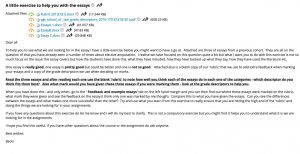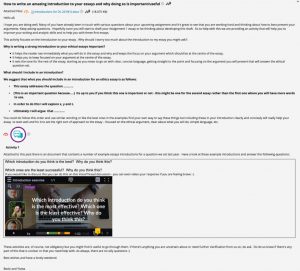Student Marking exercises
In her courses, Becki regularly uses formative marking exercises to help students improve their understanding and recognition of academically good essays, what is valued and expected in excellent work. Below are shown two types of such marking activites, one that students complete independently and one where students activites shared online.
Becki regularly uses marking exercises to help students with argumentation and structuring of an essay, The activitiy consists of giving students three essays (a really good, a medium and a not to good essay) and a marking rubric. The marking rubric can be structured on the aspects that are being targeted in this case the headings are structure and argumentation. Students are asked to read the three essays and, following the rubric provided, write down how well students think each of the three essays do on each of the rubric categories. Students are also asked to look at the descriptors and give a mark to the essay.
After students completing this activity individually they can then go and see what feedback and grade was provided by tutor/marker, and compare and consider what makes one essay better than others.
The exercise is not mandatory and takes place outside class and on a self-assessment basis. Becki encourages students who have questions to proactively approach her.
Click on the image below to see this example of a ‘Marking exercise’ to help with argumentation and structuring of an essay:
A similar exercise – this time to help students with writing a introduction for their essay and thinking about what to include and what to focus on – is also regularly used by Becki. In this second case students share their marking rubrics with the class via VoiceThread and Becki provides oral feedback to the class collectively.
Click on the image below to see an example of marking exercise to help students producing a good introductions
Evaluation / Student Feedback
Benefits
A prime purpose of formative feedback is to enable students to become proficient self-assessors (Sadler, 1989). The marking exercises:
- Made standards and marking criteria explicit to students; but moreover, assisted in developing a shared understanding of assessment criteria and standards
- Motivated students to improve, allowing them to self-assess and monitor their progress.
- When feedback on summative exercises was provided students were able to understand their grade and feedback better.
Top Tips
References
Sadler, D. R. (1989). Formative assessment and the design of instructional systems. Instructional Science, 18(2), 119-144.
Black, P., & Wiliam, D. (1998). Assessment and classroom learning. Assessment in Education, 5(1), 7-74.
Chanock, K. (2000). Comments on Essays: Do students understand what tutors write? Teaching in Higher Education, 5(1), 95-105.
Rust, C., Price, M., & O’Donovan, B. (2003). Improving Students’ Learning by Developing their Understanding of Assessment Criteria and Processes. Assessment & Evaluation in Higher Education, 28(2), 147-164.
O’Donovan, B., Price, M., & Rust, C. (2004). Know what I mean? Enhancing student understanding of assessment standards and criteria. Teaching in Higher Education, 9(3), 325-335.

School: Social Sciences
Academic: Becki Bennett
Course: Various
Themes: Assessment, rubrics
Ref: 019



0 Comments